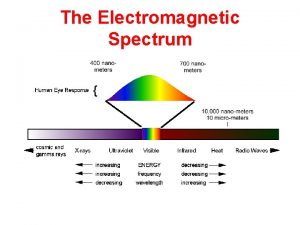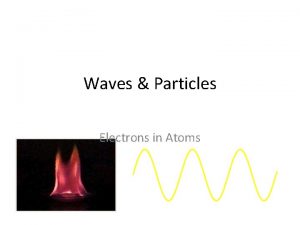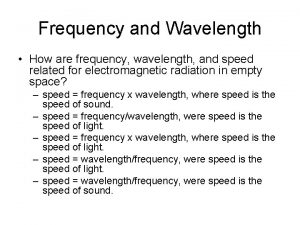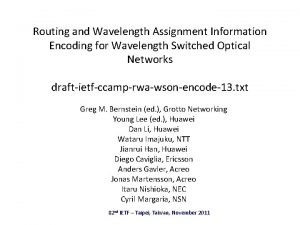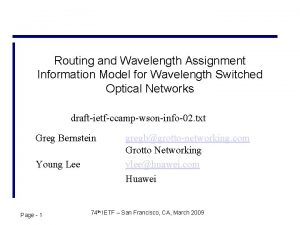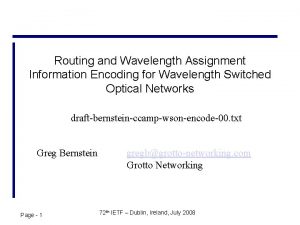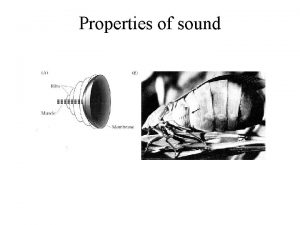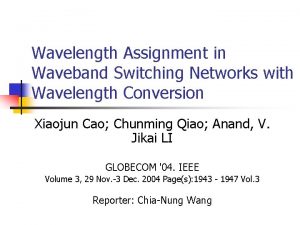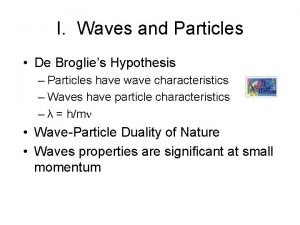Waves and particles Ch 4 Waves Wavelength the
















- Slides: 16

Waves and particles Ch. 4

Waves • Wavelength (λ)-the distance between corresponding points on adjacent waves. • • Frequency (ν) -defined as the number of waves that pass a given point in a specific time. • • meters, centimeters, or nanometers hertz (Hz) = 1/s Amplitude (A) - distance from the origin to the trough or crest


EM Spectrum H i g h E n e r g y L o w E n e r g y

EM Spectrum H i g h L o w E n e r g y R red O orange Y G. yellow green B blue I indigo V violet E n e r g y

Frequency and Wavelength • c=λv • • c= speed of light m/s, λ= wavelength m, v= frequency s-1 or 1/s c is a constant that equals 3. 00 x 108 m/s Therefore frequency and wavelength are inversely proportional.

• Ex. Find the frequency of a photon with a wavelength of 434 nm ν = c/λ λ = 434 nm c = 3. 00 × 108 m/s This is the answer you should get: Solve for v ν = 6. 91 × 1014 Hz

Quantum Theory • • Planck (1900) • Observed - emission of light from hot objects • Concluded - energy is emitted in small, specific amounts (quanta) Quantum - minimum amount of energy change

Quantum Theory • Einstein (1905) • Observed - photoelectric effect • Concluded - light has properties of both waves and particles • • “wave-particle duality” Photon - particle of light that carries a quantum of energy

Photoelectric Effect • • photoelectric effect- emission of electrons from a metal when light shines on the metal. • no electrons were emitted if the light’s frequency was below a certain minimum regardless of lights intensity. • light form of energy able to knock loose an electron from a metal. wave theory of light- light any frequency could supply enough energy to eject an electron.

Quantum Theory • The energy of a photon is proportional to its frequency. E=h ν • E: energy (J, joules) • h: Planck’s constant(6. 6262 × 10 -34 J·s) • ν: frequency (Hz)

EX: Find the energy of a red photon with a frequency of 4. 57 × 1014 Hz. GIVEN: __________ E=? ν = 4. 57 × 1014 Hz h = 6. 6262 × 10 -34 J·s WORK: ___________ E = hν E = (6. 6262 × 10 -34 J·s) (4. 57 × 1014 Hz) E = 3. 03 × 10 -19 J

Bohr Model of an Atom

Bohr Model • e- exist only in orbits with specific amounts of energy called energy levels • Therefore… • e- can only gain or lose certain amounts of energy • only certain photons are produced

Bohr Model 65 4 3 2 1 • Energy of photon depends on the difference in energy levels • Bohr’s calculated energies matched the IR, visible, and UV lines for the H atom

Other Elements • Each element has a unique bright-line emission spectrum. • “Atomic Fingerprint” • Helium • Bohr’s calculations only worked for hydrogen! ☹
 Longest wavelength in electromagnetic spectrum
Longest wavelength in electromagnetic spectrum Em spectrum wavelength
Em spectrum wavelength Compare and contrast p waves and s waves using venn diagram
Compare and contrast p waves and s waves using venn diagram Difference between mechanical and electromagnetic waves
Difference between mechanical and electromagnetic waves Examples of mechanical wave
Examples of mechanical wave Transfer of energy when a wave disappears into a surface
Transfer of energy when a wave disappears into a surface Carbon dioxide temperature
Carbon dioxide temperature Mechanical waves and electromagnetic waves similarities
Mechanical waves and electromagnetic waves similarities Mechanical and electromagnetic waves similarities
Mechanical and electromagnetic waves similarities Seismic waves
Seismic waves Electromagnetic and mechanical waves
Electromagnetic and mechanical waves Differences between constructive and destructive waves
Differences between constructive and destructive waves Sound is a transverse wave true or false
Sound is a transverse wave true or false The wave chapter 13
The wave chapter 13 Whats a reflected sound wave
Whats a reflected sound wave Examples of mechanical and electromagnetic waves
Examples of mechanical and electromagnetic waves Is a seismic wave mechanical or electromagnetic
Is a seismic wave mechanical or electromagnetic
